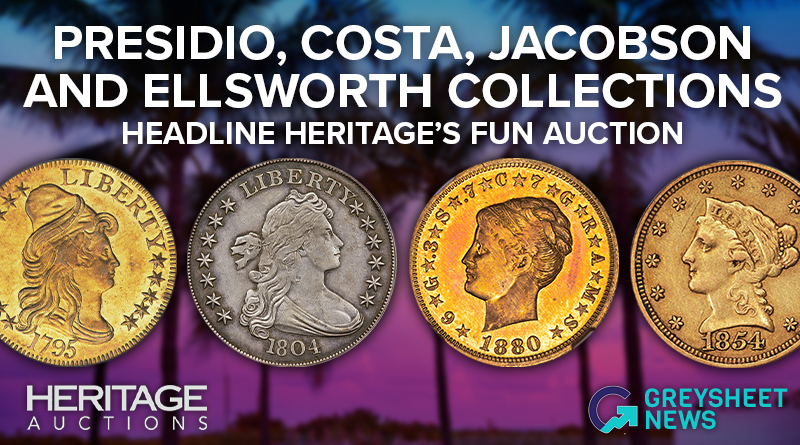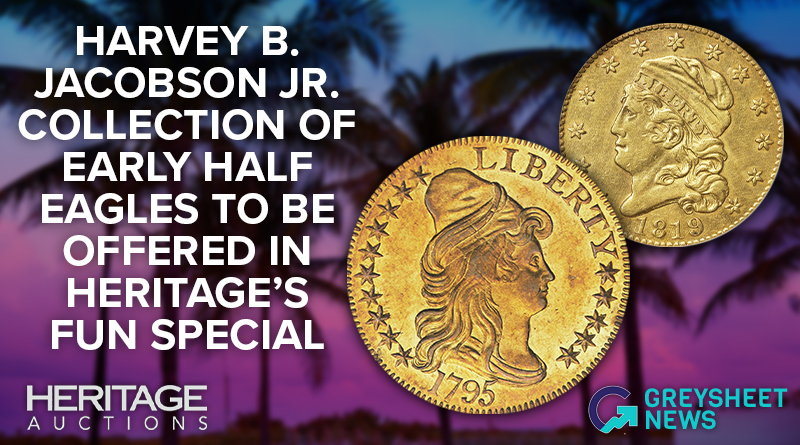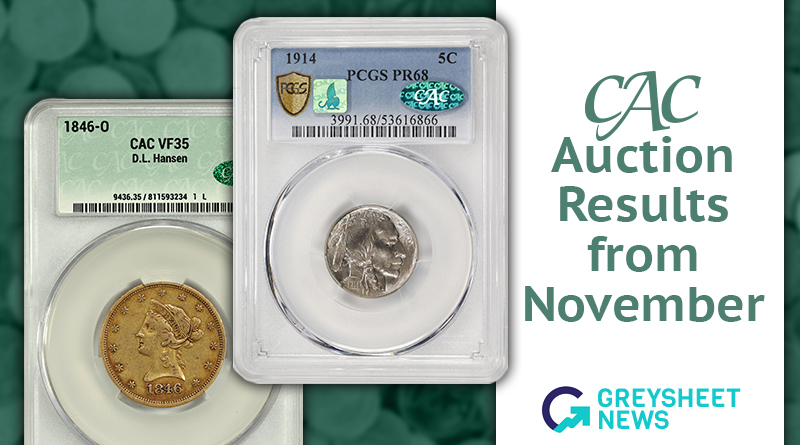Greysheet & CPG® PRICE GUIDE
- U.S. Coins /
- Pattern Coinage /
-
Patterns (1838) Values
Year
Sort by
About This Series
History and Overview
No patterns are known bearing the date 1837, although certain 1836-dated Gobrecht silver dollars (of a variety with the name on the base, and medal-turn alignment) were struck early in 1837. In June 1838, the Mint Cabinet, or reference collection of coins, was inaugurated, and thenceforth served as a repository for selected impressions of regular coinage as well as patterns. At the time, Mint officials regularly exchanged coins with numismatists.
In 1838, new half dollar and silver dollar patterns were produced. Most of the dies were by Christian Gobrecht (except for the reverse die used to coin J-75a and J-75b, a die of 1859 by Paquet).
It is likely the half dollar was selected as the primary denomination for patterns of this year, as the design of the dollar, struck for circulation in 1836, may have been considered as having been completed. Now it was time to turn attention to the second highest-value silver coin.
Basically, the obverse dies for the 1838 half dollar pattern coinage are three, numbered here for convenience, probably in the order that the dies were made:
Half Dollar Obverse Dies of 1838
Obverse 1: “Liberty head.” Gobrecht’s head of Liberty facing left, luxuriant tresses falling to her shoulder, with the word LIBERTY on the ribbon in her hair, seven stars to the left, six stars to the right, and the date 1838 below. This is the die that Snowden attributed to Kneass. • Used with J-72 to J-75b.
Patterns of 1838
Obverse 2: “Liberty seated, raised letters.” Liberty Seated motif as employed on the 1836 Gobrecht silver dollar, with the word LIBERTY in raised rather than incuse letters, and with 13 stars to the left and right, the date 1838 below. Date in a gentle curve. All strikings from this die have been original issues. • Used with J-76b, J-79, J-82, J-83.
Obverse 3: “Liberty seated, incuse letters.” Liberty Seated motif and details as foregoing, except with the word LIBERTY in incuse letters. Date straight (not gently curved). • Used with J-76 to J-78 (restrikes), J-79a (original), and J-80, J-81 (restrikes).
The reverse motifs employed for the 1838 pattern half dollar coinage are several, including one (on J-82) from 1836 and another possibly created in 1858 (J-222 of 1858, used extensively in 1859).
Half Dollar Reverse Dies of 1838
Reverse A: “Perched eagle holding four arrows.” Perched eagle holding olive branch and four arrows, head turned towards viewers right. UNITED STATES OF AMERICA above, HALF DOLLAR below. • Used with J-72, J-76 to J-78.
Reverse B: “Flying eagle in plain field.” Eagle flying to the left, mouth open, neck feathers somewhat ruffled. UNITED STATES OF AMERICA above, HALF DOLLAR below. • Used with J-73, J-74, J-79, J-79a.
Reverse C: “Regular reverse of 1838.” Perched upright eagle holding olive branch and three arrows, UNITED STATES OF AMERICA above, denomination as HALF DOL. below. • Used with J-75, J-83.
Reverse D: “Paquet’s perched eagle, broken ribbon.” Perched eagle with a ribbon across the shield, continuing to the eagle’s beak, eagle’s head facing to viewer’s left, olive branch and arrows below. Legends in tall letters, UNITED STATES OF AMERICA / HALF DOLLAR. Broken ribbon; groups of three vertical lines in the shield; six tail feathers; split wingtip at right; stem or half-leaf above A (in HALF). By engraver Anthony C. Paquet. Listed in the present text as J-75a and J-75b (listed out of order in Judd, seventh edition, under 1859, as J-254 and J-255). Same as Reverse B of 1859, in the 1838-dated die combination extensively relapped with some details ground off the die. • Used with J-75a, J-75b.
Reverse E: “Perched eagle, side view, facing left, holding arrows and branch.” Eagle perched, view from side, facing left in the manner of a flying eagle, but with tail downward and with an olive branch and arrows below. Inscription UNITED STATES OF AMERICA / HALF DOL around. • Used with J-80, J-81.
Reverse F: “Regular reverse of 1836.” Perched eagle facing viewer, shield on breast, head turned to observer’s left, talons holding olive branch and three arrows. UNITED STATES OF AMERICA above, 50 CENTS below. The style used on regular-issue reeded-edge Capped Bust half dollars of 1836 and 1837. • Used with J-82.
The preceding dies occur in several combinations in both original (contemporary with 1838) and restrike (1859 and later) productions.
Pattern silver dollars are known from a single 1838 obverse die, with Liberty seated, LIBERTY raised on the shield, and with 13 stars to the left and right, date 1838 below. Two reverse dies were employed, one with 26 stars (as used in 1836 for J-60) and the other without stars. It is believed that the use of the 26-star die was limited only to restrikes, as the stars were redundant with those on the obverse. No silver dollars were struck for circulation in 1838, and thus all are patterns.6 See “Die Alignment of Gobrecht Dollars” under Patterns of 1836, above.
Collecting Perspective
The half dollar patterns of 1838 provide a fertile field for the specialist, as many different varieties exist. It is impossible to collect them all, and therein lies the challenge to acquire as many different varieties as possible. However, if an effort is made to collect at least one impression from each obverse and reverse die, success may be nearer to reality.
Collectors have paid little attention to the status of originals vis-à-vis restrikes. Today most certified coin holders do not list the weight, and sometimes make it impossible to tell the difference without removing them from their plastic holders. All 1838 pattern half dollars are scarce, and most are quite rare.
The pattern silver dollars of 1838 are in special demand as they are listed in A Guide Book of United States Coins and thus play to a wider audience. Of the three dates of Gobrecht dollars (without regard to die combinations), 1836, 1838, and 1839, the 1838 is regarded as the rarest. The usually seen 1838 variety has an obverse with stars and a starless reverse, was struck in silver, and has a reeded edge.
Catalog Detail
Legal Disclaimer
The prices listed in our database are intended to be used as an indication only. Users are strongly encouraged to seek multiple sources of pricing before making a final determination of value. CDN Publishing is not responsible for typographical or database-related errors. Your use of this site indicates full acceptance of these terms.

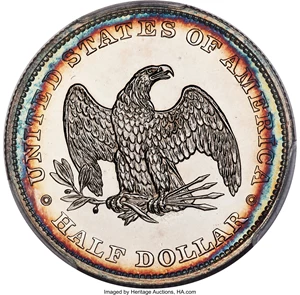


















From the Greysheet Marketplace
Buy Now: $6,500.00
Buy Now: $3,695.00
Buy Now: $2,890.63
Buy Now: $120,000.00
Buy Now: $38,900.00
Buy Now: $5,500.00
Buy Now: $37,000.00
Buy Now: $3,121.88
Buy Now: $37,000.00
Buy Now: $31,500.00
Related Stories (powered by Greysheet News)
View all news
Greysheet Catalog Details
History and Overview
No patterns are known bearing the date 1837, although certain 1836-dated Gobrecht silver dollars (of a variety with the name on the base, and medal-turn alignment) were struck early in 1837. In June 1838, the Mint Cabinet, or reference collection of coins, was inaugurated, and thenceforth served as a repository for selected impressions of regular coinage as well as patterns. At the time, Mint officials regularly exchanged coins with numismatists.
In 1838, new half dollar and silver dollar patterns were produced. Most of the dies were by Christian Gobrecht (except for the reverse die used to coin J-75a and J-75b, a die of 1859 by Paquet).
It is likely the half dollar was selected as the primary denomination for patterns of this year, as the design of the dollar, struck for circulation in 1836, may have been considered as having been completed. Now it was time to turn attention to the second highest-value silver coin.
Basically, the obverse dies for the 1838 half dollar pattern coinage are three, numbered here for convenience, probably in the order that the dies were made:
Half Dollar Obverse Dies of 1838
Obverse 1: “Liberty head.” Gobrecht’s head of Liberty facing left, luxuriant tresses falling to her shoulder, with the word LIBERTY on the ribbon in her hair, seven stars to the left, six stars to the right, and the date 1838 below. This is the die that Snowden attributed to Kneass. • Used with J-72 to J-75b.
Patterns of 1838
Obverse 2: “Liberty seated, raised letters.” Liberty Seated motif as employed on the 1836 Gobrecht silver dollar, with the word LIBERTY in raised rather than incuse letters, and with 13 stars to the left and right, the date 1838 below. Date in a gentle curve. All strikings from this die have been original issues. • Used with J-76b, J-79, J-82, J-83.
Obverse 3: “Liberty seated, incuse letters.” Liberty Seated motif and details as foregoing, except with the word LIBERTY in incuse letters. Date straight (not gently curved). • Used with J-76 to J-78 (restrikes), J-79a (original), and J-80, J-81 (restrikes).
The reverse motifs employed for the 1838 pattern half dollar coinage are several, including one (on J-82) from 1836 and another possibly created in 1858 (J-222 of 1858, used extensively in 1859).
Half Dollar Reverse Dies of 1838
Reverse A: “Perched eagle holding four arrows.” Perched eagle holding olive branch and four arrows, head turned towards viewers right. UNITED STATES OF AMERICA above, HALF DOLLAR below. • Used with J-72, J-76 to J-78.
Reverse B: “Flying eagle in plain field.” Eagle flying to the left, mouth open, neck feathers somewhat ruffled. UNITED STATES OF AMERICA above, HALF DOLLAR below. • Used with J-73, J-74, J-79, J-79a.
Reverse C: “Regular reverse of 1838.” Perched upright eagle holding olive branch and three arrows, UNITED STATES OF AMERICA above, denomination as HALF DOL. below. • Used with J-75, J-83.
Reverse D: “Paquet’s perched eagle, broken ribbon.” Perched eagle with a ribbon across the shield, continuing to the eagle’s beak, eagle’s head facing to viewer’s left, olive branch and arrows below. Legends in tall letters, UNITED STATES OF AMERICA / HALF DOLLAR. Broken ribbon; groups of three vertical lines in the shield; six tail feathers; split wingtip at right; stem or half-leaf above A (in HALF). By engraver Anthony C. Paquet. Listed in the present text as J-75a and J-75b (listed out of order in Judd, seventh edition, under 1859, as J-254 and J-255). Same as Reverse B of 1859, in the 1838-dated die combination extensively relapped with some details ground off the die. • Used with J-75a, J-75b.
Reverse E: “Perched eagle, side view, facing left, holding arrows and branch.” Eagle perched, view from side, facing left in the manner of a flying eagle, but with tail downward and with an olive branch and arrows below. Inscription UNITED STATES OF AMERICA / HALF DOL around. • Used with J-80, J-81.
Reverse F: “Regular reverse of 1836.” Perched eagle facing viewer, shield on breast, head turned to observer’s left, talons holding olive branch and three arrows. UNITED STATES OF AMERICA above, 50 CENTS below. The style used on regular-issue reeded-edge Capped Bust half dollars of 1836 and 1837. • Used with J-82.
The preceding dies occur in several combinations in both original (contemporary with 1838) and restrike (1859 and later) productions.
Pattern silver dollars are known from a single 1838 obverse die, with Liberty seated, LIBERTY raised on the shield, and with 13 stars to the left and right, date 1838 below. Two reverse dies were employed, one with 26 stars (as used in 1836 for J-60) and the other without stars. It is believed that the use of the 26-star die was limited only to restrikes, as the stars were redundant with those on the obverse. No silver dollars were struck for circulation in 1838, and thus all are patterns.6 See “Die Alignment of Gobrecht Dollars” under Patterns of 1836, above.
Collecting Perspective
The half dollar patterns of 1838 provide a fertile field for the specialist, as many different varieties exist. It is impossible to collect them all, and therein lies the challenge to acquire as many different varieties as possible. However, if an effort is made to collect at least one impression from each obverse and reverse die, success may be nearer to reality.
Collectors have paid little attention to the status of originals vis-à-vis restrikes. Today most certified coin holders do not list the weight, and sometimes make it impossible to tell the difference without removing them from their plastic holders. All 1838 pattern half dollars are scarce, and most are quite rare.
The pattern silver dollars of 1838 are in special demand as they are listed in A Guide Book of United States Coins and thus play to a wider audience. Of the three dates of Gobrecht dollars (without regard to die combinations), 1836, 1838, and 1839, the 1838 is regarded as the rarest. The usually seen 1838 variety has an obverse with stars and a starless reverse, was struck in silver, and has a reeded edge.
Catalog Detail
Legal Disclaimer
The prices listed in our database are intended to be used as an indication only. Users are strongly encouraged to seek multiple sources of pricing before making a final determination of value. CDN Publishing is not responsible for typographical or database-related errors. Your use of this site indicates full acceptance of these terms.



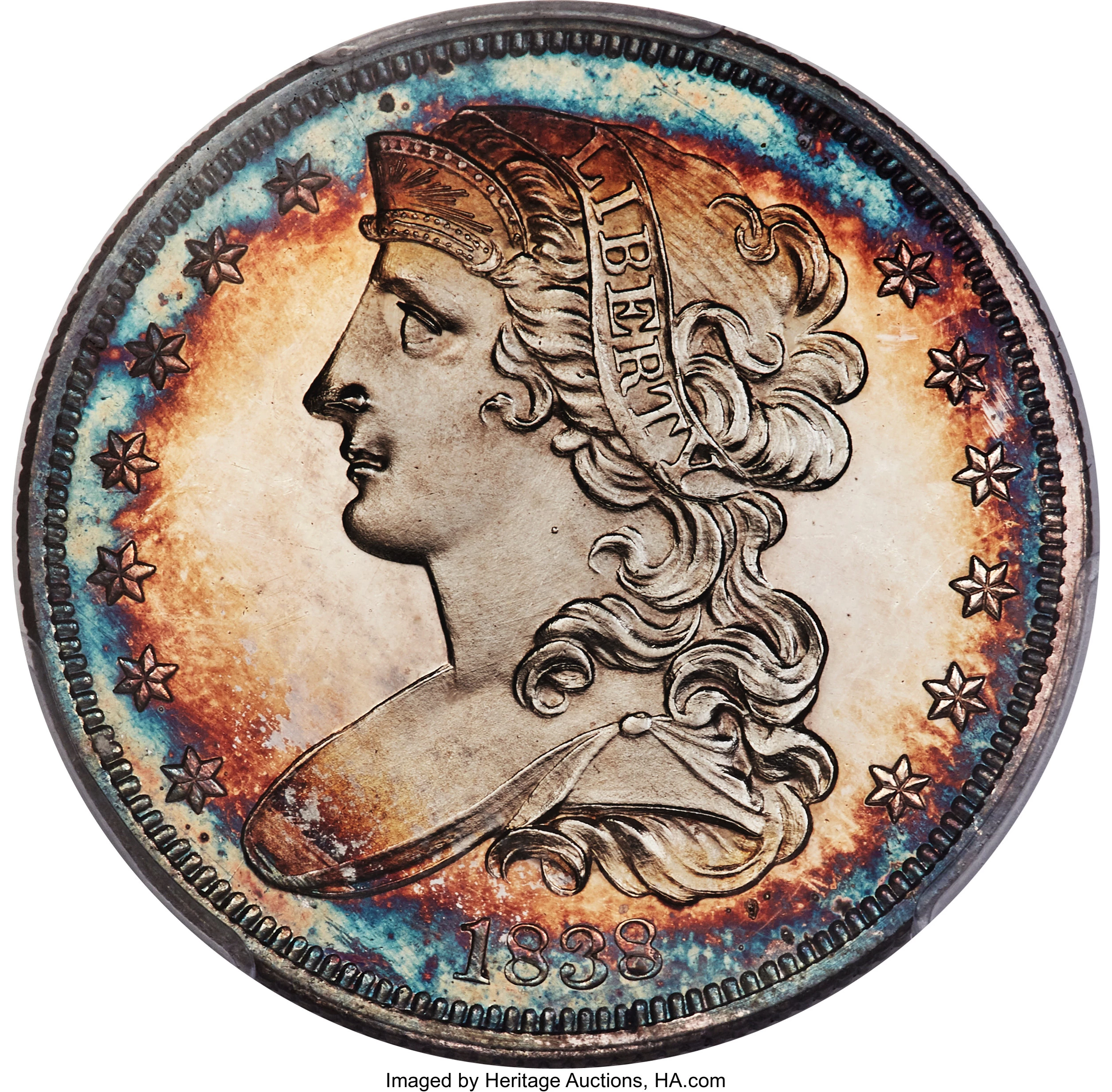

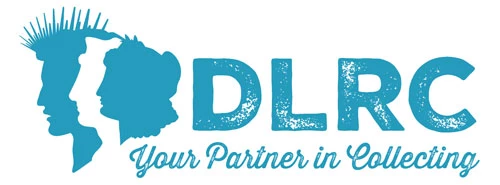




 Loading more ...
Loading more ...









